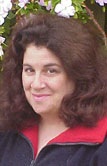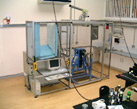May 2002 Article Tennis Server
|

 |
Dr. Stuart Miller, ITF Technical Manager
What's the latest in tennis technology and how will it affect the game? Dr. Stuart Miller has the responsibility of knowing the answers to those questions. Educated in Great Britain and holding a doctorate with an emphasis in biomechanics and motor control, Dr. Miller took center court as the International Tennis Federation (ITF) Technical Manager this past December. Among Miller's many responsibilities: ball certification and tennis science, engineering and technology projects. In addition to his technical staff of four, he manages consultants and experts in tennis science and technology as well as ITF projects awarded to other investigators. He also serves on the ITF Technical Commission which recommends rule changes involving tennis equipment and facilities. Dr. Miller discussed several current ITF projects from his London office.
Tennis Ball Certification
Tennis balls are tested at the ITF under specific and identical environmentally controlled conditions (temperature, humidity, and barometric pressure). First the ball is mechanically pre-compressed 3 times by 1 inch in 3 directions. This basically "breaks in the ball," as the ball core undergoes certain initial structural changes when first compressed. (Pre-compression is a common procedure for a variety of product testing, such as athletic shoe soles.) All tests have to be completed within 2 hours of pre-compression. The mass of the ball is measured by weighing it on a scale. The diameter (the length of a straight-line through the center of the tennis ball) test is conducted by dropping the tennis ball through two circular gauges. (These look like large rings about the size of a tennis ball.) One ring's diameter is the minimum diameter for the ball type. If the ball falls through the gauge it's smaller than allowed by the rules and would be rejected. The other ring's diameter is the maximum diameter allowed. If the tennis ball doesn't fall through this ring, the tennis ball is too large and would be rejected. In the rebound test the tennis ball is dropped onto concrete from a height of 100 inches. The ball must rebound (bounce straight back up) within a certain height range. In the deformation test, a ball is squeezed between two horizontal plates under fixed loads and then released. Both the forward deformation (the deformation which makes the sides of the ball wider, emulating the deformation during a ball/court interaction) and return deformation are calibrated by the testing machine and recorded. The ball's forward and return deformations must fall within specific limits. (Details of these tests can be found in Rules of Tennis, on the ITF's site.) A ball's certification only lasts for one year. Even if that particular ball's design or manufacturing has not changed, the ball still must go through the certification tests each year. Last year, 161 different balls were approved. Where do all these tennis balls come from? "We're seeing a shift in where balls are manufactured. The three largest producers are still Europe, the United States and the Far East, but tennis balls are now manufactured all over the world primarily due to economics. Aside from the United Kingdom and the United States, balls are manufactured in Indonesia, China, the Philippines, Australia, France, Japan, Belgium and Argentina." The ITF has collected four years of informational data on tennis balls. Although manufacturers provide balls to the ITF for certification testing, balls also are sampled from shops and tournaments. "The sampling gives a broader picture of the characteristics of a manufacturer's tennis ball," said Miller. "This data also provides valuable marketing trend information -- what the market wants in a tennis ball -- as well as help track changes in tennis ball quality over time." In addition to ball certification, the ITF technical group conducts research projects into equipment and the development of new testing technologies. "What's new on the research front?" I asked Miller.
The ITF began a major court surface classification program in 2000. Each court surface product is assigned a surface pace rating, classifying it as a slow, medium or fast surface. The purpose of the classification system is to help in ball selection based on the three ball types defined in the Rules of Tennis.
Tennis Racquet Performance Characteristics
"The ITF is starting a major research project on tennis racquet performance characteristics. Game speed due to serve speed increases has been a concern. We may also be reaching the human limits of reaction time," Miller noted. Investigations into racquet power and comparisons of racquets have been limited by the inability to reproduce identical strokes. The MYO equipment can reproduce identical serves at a maximum raquet speed of 55 meters/second (about 123 miles/hour) which generates ball speeds 10% faster (165 miles/hour) than the current record serve speed (149 miles/hour). "MYO's strokes can be duplicated, over and over again. We can vary swing speed and ball impact point on the racquet. We'll be able to vary string patterns on a racquet to investigate how stringing affects racquet performance. This is going to increase our basic understanding of the generation of racquet power," Miller observed. "The equipment arrived at the end of January and is going through a benchmark/validation phase. We hope to be ready to this summer."
Tennis Ball Aerodynamics
In a collaboration with Dr. Steve Haake at the University of Sheffield, this wind tunnel data can be used in a computer code which predicts the flight path (even with spin and even after the bounce) of a tennis ball. Lift and drag information for specific balls can be used in this computer code to predict trajectory differences between balls. "We are also discussing the current ball performance tests (deformation, rebound). Are these realistic tests which capture the relevant characteristics of a tennis ball? Would, for example, performance tests which capture spinning and non-spinning ball trajectory characteristics be more relevant?"
Smaller Projects
The Future
The 2nd ITF International Congress on Tennis Science and Technology
The manufacturers, national governing boards and tours, and top tennis sport science and medicine researchers in the industry were there. This is the place; this is the conference to attend. Okay -- the banquet at the President's Club at Wimbledon was incredibly impressive too! What a view! Dinner overlooking the perfectly manicured courts of Wimbledon. Proceedings from the first conference can be obtained via Tennis Server's online bookstore.
Here are the details for the 2003 congress.
The program is divided into 4 main themes:
Open to anyone with an interest in tennis, papers and presentations are sought from a wide variety of disciplines including tennis researchers and academics, engineers, sports scientists and coaches, equipment manufacturers, and facility designers and constructors. Papers should be a maximum of 8 pages, and must be submitted by January 17, 2003. The official language of the Congress will be English. Discounts on the conference delegate fee will be given to all people who present papers.
I'd like thank Stuart again for his time and assistance in preparing this column. The ITF's commitment to proactive research and understanding of emerging technology should be applauded. Until next month --- Jani
Photos courtesy the International Tennis Federation.
This column is copyrighted by Jani Macari Pallis, Ph.D., all rights
reserved.
Dr. Jani Macari Pallis is the founder and CEO of Cislunar Aerospace,
Inc., an engineering and research firm in San Francisco. In addition
to her engineering practice, she has led two collaborations between
NASA and Cislunar, creating educational materials on the aerodynamics
of sports for pre-college students and educators. As the head of
NASA's "Aerodynamics in Sports" project, she has led a team of
researchers investigating the aerodynamics, physics and biomechanics
of tennis. The group has conducted high speed video data capture at
the US Open and research of ball/court interaction, footwork, serve
speeds, trajectories and ball aerodynamics. Pallis received a BS and
MS from the Georgia Institute of Technology, an MS in mechanical
engineering from the University of California, Berkeley and a Ph.D.
in mechanical and aeronautical engineering from the University of
California, Davis. She is a member of the Executive Committee of The
International Sports Engineering Association.
Questions and comments about these columns can be directed to Jani by
using this form.
|



October 2022 Tennis Anyone: Patterns in Doubles by John Mills. September 2022 Tennis Anyone: Short Court by John Mills. |
 You will join 13,000 other subscribers in receiving news of updates to the Tennis Server along with monthly tennis tips from tennis pro Tom Veneziano.
You will join 13,000 other subscribers in receiving news of updates to the Tennis Server along with monthly tennis tips from tennis pro Tom Veneziano. 

